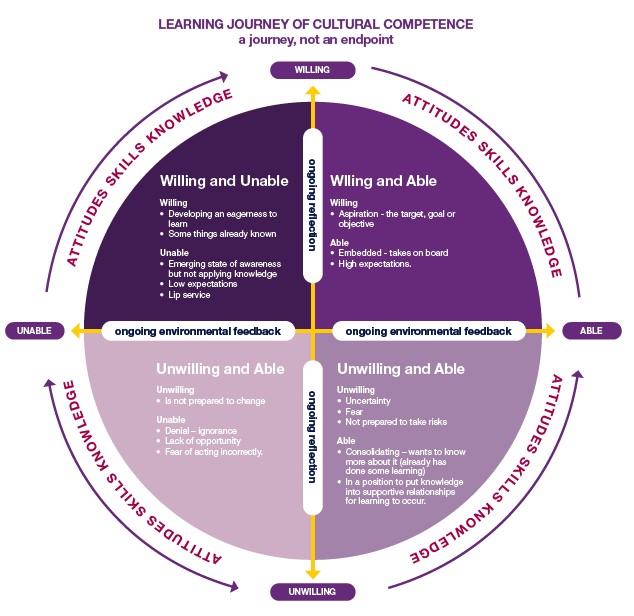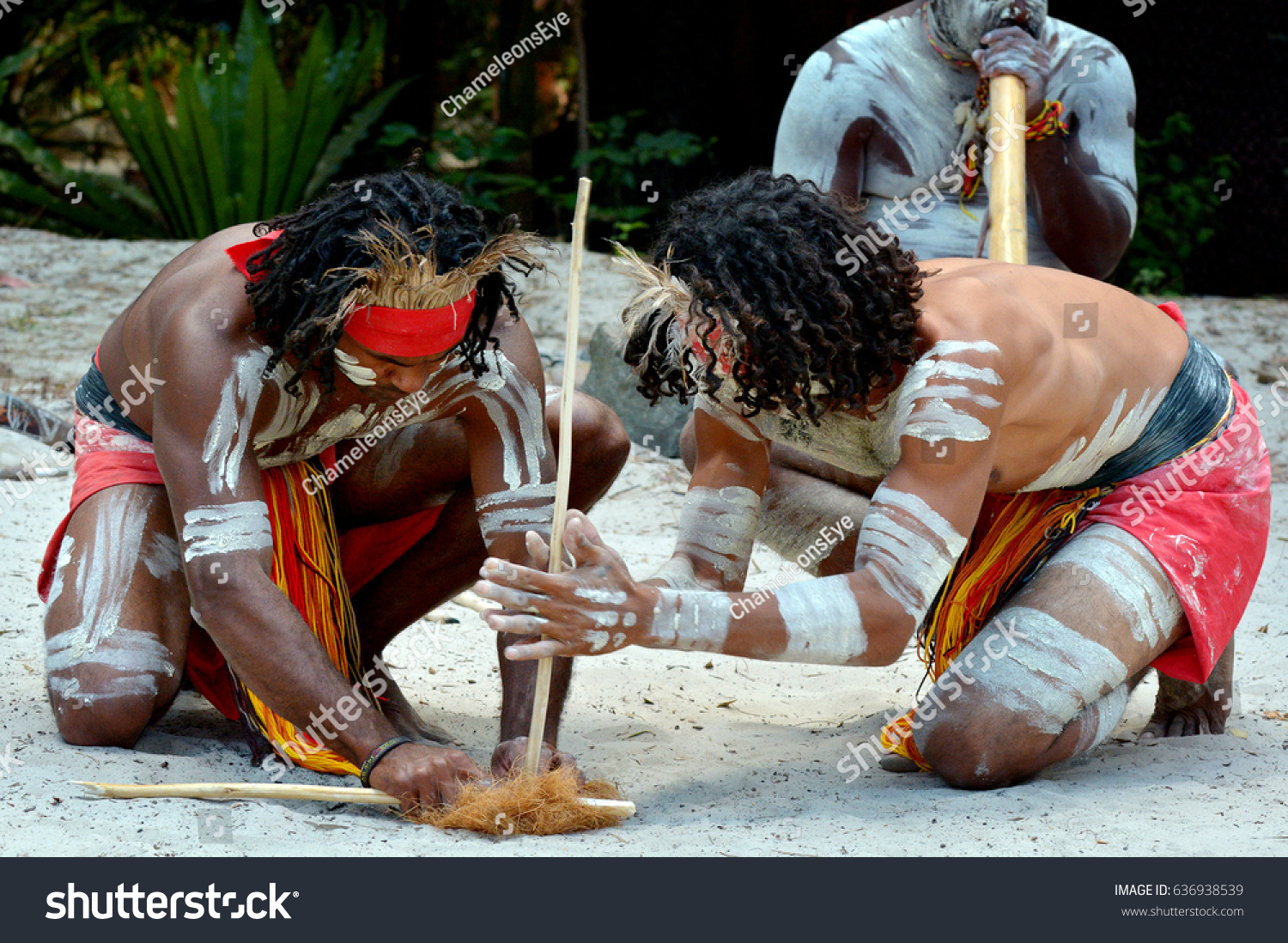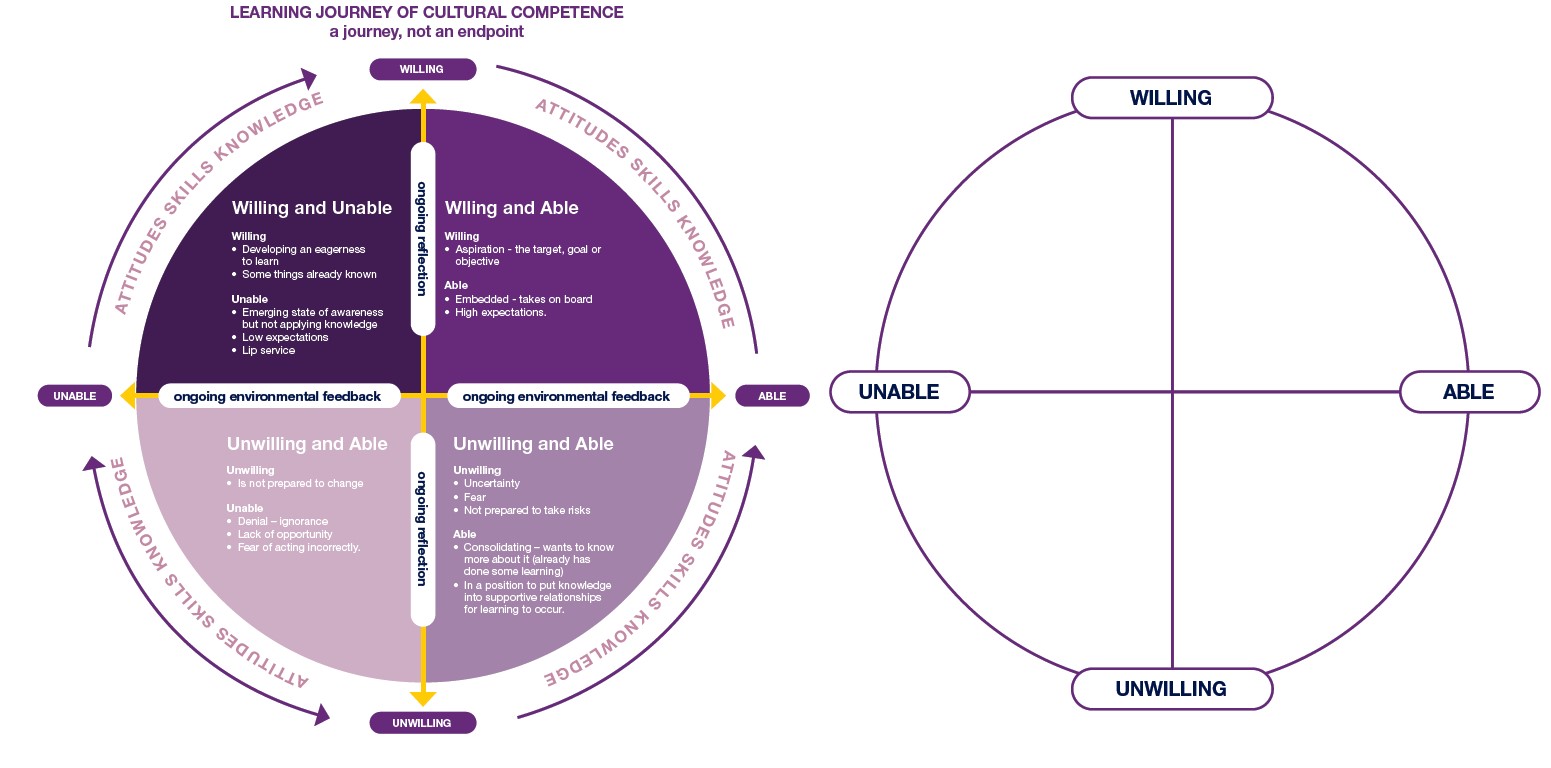Cultural competency and cultural safety in community services ensures that staff who provide community support understand their clients’ journey, have collaborated with indigenus supports in order to identify with their experiences, and understand the effects of culture and history on the way in which Aboriginal and Torres Strait Islander communicate, learn and engage. The staff must understand the impacts of trauma and how this may be internalised or externalised by a client, potenially leading to behaviours that demonstrate a need for support. Community services workers will build an environment that suppports and embraces the culture of their clients and considers how they may need and want to learn and engage with others. Community services workers must reflect and consider their own potential bias and attitudes toward culture and build professional practivces that develop their own cultural capabilities.
By the end of this chapter, you will understand:
- how to build cultural capability
- how to support culturally competent community services and related programs
- how to create a culturally safe environment.
The ability to identify and challenge one’s own cultural assumptions, one’s values and beliefs. It is about developing empathy and connected knowledge, the ability to see the world through another’s eyes, or at the very least, to recognise that others may view the world through different cultural lenses.Cross et al, 1989
Aboriginal Cultural Capability
Cultural capability is a joint effort around building cultural competency, awareness and cultural safety. It is an evolving, dynamic model addressing the learning that occurs over time.
Cultural competence means a coming together of a set of behaviours, attitudes, and policies that enable an individual or group to work collectively in cross-cultural situations. Cultural competence is based on the actions of individuals and groups responding respectfully, efficiently and effectively to people of different cultures and strengthening their sense of worth. To achieve diversity, the goal of a culturally competent society is to ensure cultural pluralism, which is the maintenance of the unique cultural identities and values of the groups within the community. Diversity is incorporated into the laws and values of the wider society, and self-worth is embedded. Community services workers need to embed Aboriginal and Torres Strait Islander perspectives in their practices.


... it is important to understand the contributing factors that impact engagement and achievement for Aboriginal and Torres Strait Islander students, such as a focus on culture and language, curriculum and pedagogy, rural and remote education, and anti-racism in schools.Australian Institute for Teaching and School Leadership
Cultural Competence in the community service Context
A culturally competent community service environment is supported by strong, inspirational leadership, relevant professional development, exposure to Aboriginal and Torres Strait Islander cultures and culturally responsive programs, and experiential opportunities. These elements support the quality services to Aboriginal and Torres Strait Islander families. Community services workers and the leadership team collaborate and work towards embedding cultural competency into their everyday practices and programs. They must model and engage in these attitudes, considerations and processes every day within the service environment.
| Resource |
|---|
| Read the following resource published by Diversity Council Australia to learn about practice principles of working with and engaging Aboriginal and Toress Strait Islander people in the community. https://www.dca.org.au/topics/aboriginal-and-torres-strait-islander-peoples/leading-practice-principles |
The Cultural Competence Continuum
Cultural competence is a journey. The table below demonstrates what that journey may look like.
| Cultural Destructiveness | Cultural incapacity | Cultural blindness | Cultural pre competence | Cultural Competence | Cultural Proficiency |
|---|---|---|---|---|---|
| Towards cultural competence | |||||
|
Characterised by: Intentional attitudes, policies and practices that are destructive to cultures and consequently to individuals within the culture. |
Characterised by: Lack of capacity to help minority clients or communities due to extremely biased beliefs and a prejudiced attitude towards those not of mainstream culture. |
Characterised by: The belief that a service or helping approach is traditionally used by the dominant culture and is universally applicable regardless of race or culture. These services ignore cultural strengths and encourage assimilation. |
Characterised by: The desire to deliver quality services and a commitment to diversity indicated by hiring minority staff, initiating training and recruiting minority members for agency leadership, but lacking information on how to maximise these capacities. This level of competence can lead to tokenism. |
Characterised by: Acceptance and respect for continuing self-assessment, careful attention to the dynamics of difference, continuous expansion of knowledge and resources, and adaptation of services to better meet the needs of diverse populations. |
Characterised by: Holding culture in high esteem – seeking to add to the knowledge base of a culturally competent practice by conducting research, influencing approaches to care, and improving relations between cultures. It also promotes self determination. |
| Activity 2A |
|---|
|
The Cultural Competence Continuum Reflect on the continuum: 1. Identify where you think you sit. Explain why. 2. Discuss what you think you could do to move up the continuum. |
| Activity 2B |
|---|
| Culturally Competent Learning Journey |
|
Create your own cycle of the culturally competent learning journey show below. Make notes in each section to guide yourself along the journey, giving yourself some starting points. Consider the self-reflective questions you might ask yourself, the goals you might set and areas you want to become more knowledgeable or competent in.
|
Cultural safety means an environment that is safe from assault, challenge or denial of a person’s identity and experience. Cultural safety is impacted by the actions, attitudes, values and systems put in place by individuals and organisations. Cultural safety means that individuals and organisations are aware of their impact on people from other cultures, including Aboriginal people, and work to build an environment where all people are treated in a culturally respectful way. Services can support cultural safety by:
- Implementing the Acknowledgement of Country within formal meetings and events
| Read |
|---|
| Read about the importance of the Acknowledgement of Country: ‘Why an Acknowledgement of Country is important (and advice on how to give one)’ from ABC Everyday https://www.abc.net.au/everyday/why-acknowledgement-of-country-is-important-and-how-to-give-one/11881902 |
- Acknowledging the traditional owners of the land with signage at the service
- Displaying Aboriginal and Torres Strait Islander flags, artwork and genuine examples of customs within the service and programs, while maintaining the artist’s copyright and intellectual property
- Celebrating with the local Aboriginal and Torres Strait Islander communities and educating the service community about dates of significance, for example, National Aborigines and Islanders Day Observance Committee (NAIDOC) week and National Aboriginal and Islanders children’s day
- Consulting with local members of Indigenous communities to ensure genuine and accurate information, customs and guidelines are being followed.
| Think |
|---|
| Reflect on how you can assess and measure whether a Community Service and its practices are culturally safe. |
Community service workers and leadership staff members are required to assess the organisation’s cultural competence considering their practices’ strenghts and weaknesses, interactions and impacts of their thoughts and actions witin the workplace.
Community service workers and leadership staff mebers need to challenge and reflect on their own beliefs, behaviours and attitudes and critically reflect on how they contribute to the valuing of diversity and understanding the dynamics of difference between community groups. They need to engage in professional development and take time to consult with indigenous groups.
When community service workers look deeper and consider what factors support their clients they can also begin and reframe and rethink what they do and, when required, seek support and advice.
A Trust - Based Approach
Community service workers need to build on their clients strenghts and place value on their home life, relationship and culture, while factoring these aspects into their support plan.
| Think |
|---|
| Critical reflection is a meaningful and ongoing journey that works towards continuous quality improvement for the individual, the service and all stakeholders. |
Watch: Engaging respectfully with Aboriginal and Torres Strait Islander clients: 12.44
| Read |
|---|
| Read The starting point: Investment in relationships to learn about fundamental step in engaging and working respectfully and effectivelly with Aboriginal and Torres Strait Islander people https://emergingminds.com.au/resources/the-starting-point-investment-in-relationships/ |
| Activity 2C | ||
|---|---|---|
| Knowing Yourself | ||
| Watch the video titled ‘How to Know Yourself’ by The School of Life: https://www.youtube.com/watch?v=4lTbWQ8zD3wReflect and answer the questions below: | ||
| 1. | Write down five things you know about yourself. Attributes might include quiet, patient and talkative for example. How do you know this about yourself? Is it because you have been told so or because you have reflected on your behaviour? | |
| 2. | Write down five things you know about your culture, history and background. Consider how these things have impacted on you as a person. | |
| 3. | Consider your early teachers and the parenting styles you were brought up with. How has this impacted the way you want to guide your clients to find their self worth and build upon their strenghts. | |
| 4. | Explain how you might ensure that you follow your beliefs instead of those of the crowd. | |
| 5. | Write down five things you know about the Aboriginal culture. Consider, are these facts, or what you have been led to believe? How can you confirm and find out? | |
| 6. | Write down five perspectives you have on diversity and inclusion. (Remember, no one will see this, it is just for you to reflect on). How could this impact positively or negatively on your work with children, families, colleagues and communities? | |
| 7. | List what you wish you knew or could do better in terms of diversity and inclusion, and complete the knowledge matrix below. | |
| KNOWN | Things you are aware of and understand: | Things you are aware of but do not understand: |
| UNKNOWN | Things you understand but are not knowingly aware of: | Things you do not understand and are not aware of: |
Empathy Towards Others
Watching the clips above may have been the beginning of a better understanding of what it is like to be in another’s shoes. You may already have experience working with diverse groups, or you may have experience yourself as a marginalised individual or group. Awareness supports a better understanding of the feelings of others and can bring about a change in attitudes and perspectives. It is important to come to these realisations through such experiences and knowledge instead of following a crowd and their thoughts, even if these are people close to you.
Asking reflective questions often, as an ongoing process, encourages education support officers to consider what they do and why they do it. This reflection confronts the potential impacts their actions and beliefs have on their profession and role, and ultimately on others. Anyone working with people should be reflecting on their beliefs, actions, perspectives and how these show through their internal and external behaviours.
Reflective questions you may ask yourself could include:
- What do I understand about the student and their family?
- What do I need to know more about?
- How will this benefit everyone?
- Where can I find out more?
- How can I gain more experience?
- Why does my influence on the student, family and community matter?
- How am I a part of society’s identification and what can I do to support diversity and inclusion?
There are various avenues an a community services worker can access to get a better understanding of their clients and their needs.
Here are some ideas for seeking information:
- Consulting the family
- Consulting the client
- Consulting with colleagues
- Learning about the client’s previous education support, teachers or external services (agencies and intervention services for example)
- Seeking advice from Indigenous elders or community members within your local area
- Seeking advice of advocacy organisations and government departments, such as:
| The Department of Education website: ‘Supporting Aboriginal children and their families’ https://www.vic.gov.au/early-childhood-service-funding-and-grants?Redirect=1 |
| The SNAICC website: ‘Aboriginal Early Childhood Services Support Unit, NSW https://www.snaicc.org.au/aboriginal-early-childhood-services-support-unit-nsw/ |
| The SNAICC website: https://www.snaicc.org.au/ |
| The Narragunnawali website to access more professional development opportunities: ‘Reflecting On Our Cultural Identities’ https://www.narragunnawali.org.au/professional-learning/14/reflecting-on-our-cultural-identities |
There are hundreds of distinct Aboriginal and Torres Strait Islander communities, cultural and language groups, clans, families and kinship networks in Australia. Therefore, it is important not to assume all groups have the same customs, language or systems.
| Activity 2D |
|---|
| Map of Indigenous Australia |
| Using the map found in the link below, identify your local Indigenous clan, group or tribe. Research this group further to distinguish their customs, systems and language. ‘Map of Indigenous Australia’ from AIATSIS https://aiatsis.gov.au/explore/map-indigenous-australia |
Many community services have reflected upon their practices and realised they may have been misinformed about their understanding of appropriate interactions and protocols with the Aboriginal community. Therefore, Aboriginal and Torres Strait Islander communities are working to support the community services organisations and understanding between cultures by providing information about protocols that need to be used with their culture. These protocols can include:
- The Welcome to Country
- An Acknowledgement of Country
- Smoking Ceremonies
- Positivity toward the culture
- Communication styles and strategies, including use of silence, body language, jargon, touch and eye contact
- Supporting cultural connectedness and identities
- Using preferred terms and titles
- Use of cultural customs by non-indigenous peoples
- Use of time and place
- The need to consult with elders
- Men and women’s business
Using information with sensitivity and awareness of appropriate interpretation.
| Read |
|---|
| Read the following document prepared by the Australian Government on how to communicate with Aboriginal and Torres Strait Islander audiences: ‘Communicating with Aboriginal and Torres Strait Islander Audiences’ https://view.officeapps.live.com/op/view.aspx?src=https%3A%2F%2Fqcg-media.s3.amazonaws.com%2Fmedia%2Fuploads%2F116799%2F2021%2F08%2F20210819_494591_CommunicatingAboriginalandTorresStraitIsla_biTCU88.docx&wdOrigin=BROWSELINK |
| Read the following research paper by researchers Annabel Jones and Bryony Barnett titled ‘Guidelines for ethical and effective communication for researchers working in Torres Strait’ to learn more about culturally appropriate communication with people from Torres Strait: https://www.tsra.gov.au/__data/assets/pdf_file/0008/2051/torres_protocols.pdf |
| Read the following document prepared by Queensland Health to learn more about how to communicate with Aboriginal and Torres Strait Islander people: ‘Communicating effectively with Aboriginal and Torres Strait Islander people’ https://www.health.qld.gov.au/__data/assets/pdf_file/0021/151923/communicating.pdf |
| Read the following informational booklet by Indigenous Cultural Hub to learn more about how to engage with Aboriginal communities: ‘How can you engage with your local Aboriginal community?’ https://www.vacca.org/cultural-hub |
Community services workers and leadership staff members have the responsibility of assessing how to build elements of culture into the programs and services offered. This may become evident by:
- Engaging with community members
- Participation
- Self-determination
- Strategies that make sense or match with the client.
Consider the above readings and assess areas of support and how you might promote community and client engagement. Assess the power of selfdetermination within the group. How may you alter programs, strategies and evaluation?
Strategies might include:
- Building trust
- Visual story telling
- Liaising, inviting and including community members into the programs
- Visual, active and hands-on learning activities
- Reading non-verbal cues of clients to assess if they understand or want to contribute, but understanding that the program delivery may be outside of their cultural ways
- Having high expectations for the client and varied expectations for the community support worker
- Providing relative examples in learning programs and services offered (asking whether examples are relevant to their culture)
- Connecting with the natural world
- Keeping in mind trauma and background experiences
- Building a community for the participants in the support programs
- Giving the participants in the support programs autonomy and agency
- Considering that English is a second language for many of the clients
- Sharing with the clients your knowledge, interest and passion for understanding more about them and their community – let them lead the knowledge sharing
- Providing opportunities for peer coaching and supporting within the support programs
- Planning for calm, motivating and mindful support programs.
| Activity 2E |
|---|
| Indigenous Community Engagement Download and read part 4.1 and 4.2 of the Aboriginal Comunity Engagement Strategy developed by Victorian Equal Opportunity and Human Rights Commission Choose any of the 3 key themes then plan and describe how you would embed it in your community service program. https://www.humanrights.vic.gov.au/for-individuals/aboriginal-community-engagement-strategy/ |
| Review questions | |
|---|---|
| Use the following questions to check our knowledge | |
| 1. | Explain the difference between cultural competency and cultural safety. |
| 2. | Discuss what you might reflect on when you consider cultural practices. |
| 3. | List five protocols for acknowledging, interacting and communicating with Aboriginal and Torres Strait Islander communities. |
| 4. | List five places you may go to for further information or advice. |
| 5. | List five areas to consider when planning strategies for Aboriginal or Torres Strait Islander students. |

